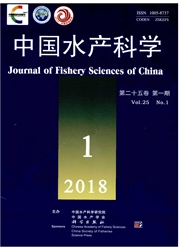

 中文摘要:
中文摘要:
本研究分析了长牡蛎(Crassostrea gigas)白壳色、黑壳色、金壳色和紫壳色4种壳色家系各生长阶段的表型性状及成贝生长和存活性状基因型与环境的互作效应。结果表明,浮游阶段10日龄后,金壳色和紫壳色家系壳高显著高于白壳色家系和对照组(<0.05);稚贝阶段40和100日龄紫壳色家系壳高显著高于对照组(<0.05),160日龄白壳色家系壳高显著小于其他家系(<0.05);成贝阶段金壳色家系壳高和总重显著高于白壳色和黑壳色家系及对照组(<0.05)。浮游阶段15和20日龄紫壳色家系存活率显著高于其他家系(<0.05);稚贝期各家系存活率差异不显著(>0.05);420日龄紫壳色家系存活率显著高于其他家系(<0.05)。基因型与环境互作效应对双岛湾和海阳所海区长牡蛎成贝壳高和壳长影响显著(<0.05),对总重和存活率的影响不显著(>0.05)。研究表明长牡蛎壳色与其生长和存活性状关联显著,成贝阶段生长和存活性状的基因型与环境互作效应相对较弱,不会对长牡蛎在两海区的育种效果产生显著影响。
 英文摘要:
英文摘要:
Color polymorphism is relatively common in marine shellfish. Shell color affects the visual perception of products which, in turn, influences consumer preference and product value. The shell color of marine mollusks is a ge-netically-based phenotypic trait and is therefore amenable to artificial selection. Furthermore, distinctive pigment colors or color patterns in several marine shellfish species are controlled by genes segregated at only one or two loci. The ge-netic control of shell pigment was recently determined for Crassostrea gigas, and the narrow-sense heritability of left-shell pigmentation was estimated at 0.59 ± 0.19. To increase the value of C. gigas sold as“singles”for the half-shell market, there has been a recent increase in interest in selective breeding for desirable shell colors in C. gigas. In par-ticular, research has focused on the relationship between shell color and phenotypic traits in C. gigas and the effect of genotype-environment interactions on adult fitness. Four shell color families (white, black, golden, and purple) and the control group were established by separately selecting corresponding parents in Rushan Bay, Weihai of Shandong Province. The larvae, spat, and adults were reared following standard practices, and the rearing conditions were identi-cal between families to minimize environmental effects. We measured the growth performance (shell height, shell length and total weight) and survival rate of these families during the larval, spat, and adult periods. We used bi-independent variables analysis to test the genotype-environment interaction effect of the phenotypic traits during the adult period. At days 10, 15, and 20, the larval shell height of the golden and purple shell families was significantly higher than that of the white shell family and the control family. At days 15 and 20, the larval survival rate of the purple shell family was significantly higher than that of other families (〈0.05). At days 40 and 100, the juvenile shell height of the purple
 同期刊论文项目
同期刊论文项目
 同项目期刊论文
同项目期刊论文
 期刊信息
期刊信息
